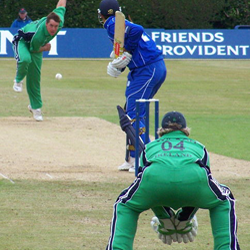
The 2015 Cricket World Cup was organised into two groups of seven teams each. In ICC terminology, ten nations are considered to be full ICC members because they engage in test match competition. It is not obvious why that classification should apply to teams engaged in ODI play. The non-test match playing ODI nations (four in this World Cup) were called 'associates', even though two of the four in 2015 had ODI ratings.
In group play, each of the seven nations per group played the six opponents in their group for a total of 21 matches per group, 42 overall. The eight teams surviving the group phase then played seven more matches in the knockout phase, each match eliminating one team, until only the champion remained. Six weeks were required to complete the 49 matches, one month of which was required for the group phase.
Scoring was up. From 2011 to 2015, the run rate (runs per over) increased by 4.5% in the group phase (from 5.08 to 5.31), by 16.6% in the knockout phase (from 4.81 to 5.61) and overall by 6.2% (from 5.04 to 5.35). So it was a great year for batsmen.
Cricket enjoys one of the most accurate official rating systems in international competition. David Kendix developed a self-adjusting system for the ICC. A team’s rating increases, decreases or remains the same depending on the match outcome, expressed on a 0-1 scale, minus the expected result, also on a 0-1 scale, based on the rating difference between the team and opponent. A similar rating system is used by the IRB for rugby union (in which the higher rated team won 84% of matches in two World Cups) and by FIFA for women’s soccer (82% rating accuracy in two World Cups). Kendix’s system is also used by the IFNA for netball (89% rating accuracy in three World Cups) and for an ICC T20 world championship (76% rating accuracy).
Kendix’s system has been used to rank teams prior to each of the last three ODI World Cups. Excluding ties and abandoned matches, there were only nine upsets where a higher rated team lost in 48 matches in 2007 (81.2% rating accuracy), ten upsets in 46 matches in 2011 (78.3% rating accuracy) and nine upsets in 48 matches in 2015 (81.2% rating accuracy).
Nearly half of the 28 upsets were by New Zealand (seven) and Ireland (five). Four of New Zealand’s upsets were at home in 2015. Ireland is a so-called associate nation that has acquitted itself quite well, with upset wins in each of the last three World Cups: 2007 (two), 2011 (one) and 2015 (two). That consistency speaks well for Ireland as a competitor with every right to join in a truly 'World Cup' in 2019. Half of the upset losses were suffered by South Africa (six), England (four) and Pakistan (four).
One argument for reducing the number of associate nations is one-sided losses by that group. It should be noted that among full member nations in 2015, South Africa defeated West Indies by 257 runs, Pakistan defeated West Indies by 150 runs, South Africa defeated Sri Lanka by nine wickets and New Zealand defeated England by eight wickets. All of those full member matches were also one-sided.
Compressing the 2019 World Cup in England
Lets accept the goal of compressing the World Cup duration. The ICC appears poised to invite only ten nations in 2019, all of which might be full members. These ten could be divided into two groups of five each, so that each nation need play only four matches in the group phase, 1/3 less than in 2015. In that way, a week could be cut from the one month long group phase. There would be 10 matches per group, 20 group matches overall.
The exact same compression can be gained by adding one associate nation and having three groups of five. Suppose that each team must play no more often than one day in four. With two groups, in four successive days, Group A could play two matches, Group B could play two matches and two days could be rest days. Five cycles totaling 20 days would accommodate the 20 group matches, requiring about three weeks instead of the month required in 2015.
For the same compression – but with three groups of five: in successive days, Group A could play two matches, Group B could play two matches, Group C could play two matches and one day could be allocated as a rest day. Five cycles would cover 20 days to accommodate 30 group matches for three groups, the same length of time that the proposed ICC system would only cover 20 matches with two groups.
The ICC would probably cut the two groups of five to eight teams for the knockout phase by taking the top four from each of the two groups. With three groups of five, the ICC could just as easily advance the top two from each group along with the two best third place teams. Any compression and advancement scenario that the ICC wants to perform with two groups of five can just as easily be done with three groups of five.
The proposed three-group structure can be outlined as follows.

Group Phase (15 teams, 30 matches) – Knockout Phase (8 teams, 7 matches)
Inclusion (with 15 teams) can replace exclusion (with ten teams). If some matches among associate nations are less well attended, so be it. Those matches are terribly important to those players, to the people in the nations that they represent and to the future development of cricket. Three groups of five would produce income from 30 group matches instead of 20 and would add more income from hotels, restaurants and the various ancillary requirements of the supporters for five more teams. Ireland has proven that an associate team can win. Ireland deserves inclusion, so lets make 2019 a truly World Cup worthy of one of the world’s greatest sports.




